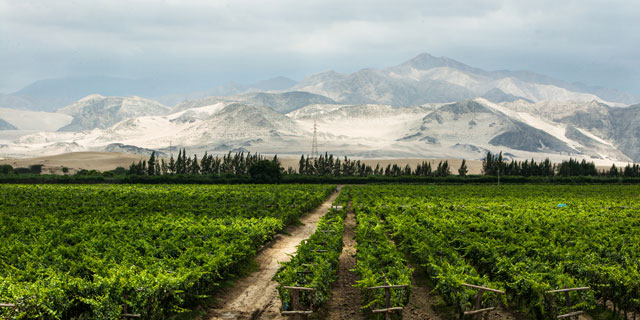It’s not quite time to celebrate Peru as a wine tasting destination, but if the passion and enthusiasm applied to all things culinary is anything to go by, it’s quite likely that in five to ten years the landscape will be completely different.
Peruvian wine is not unlike pisco. Five years ago it was a completely undervalued industry; its name conjured little more than memories of frothy sours and sharp hangovers. A few premium labels had started to appear, but it still seemed like a long uphill climb to get wider recognition.
These days, the supermarket shelves heave with choice, people talk about their preference for Quebranta, Torontel, or Albilla, and bartenders are beginning to treat it like a fine spirit. Now, it’s an honor to present a fine pisco as a gift, and this, says Carlos de Piérola, a wine writer and international judge, is where the Peruvian wine industry needs to get to.
Changing Attitudes
De Pierola is the founder of Barricas, a local, wine-focused website, and is the driving force behind Lima’s first Peruvian Wine Week (which will take place every second week of July). The goal, he explains, is to help wineries and consumers get to know each other a little better, to overcome the prejudices created by the low quality wines that have dominated the market.
And the best way to do this is through food. Restaurants all over the city opened their doors to this mini-festival, from Gaston Acurio’s La Mar to Hector Solís’ Fiesta and Pedro Miguel Schiaffino’s Amaz, and participated with special offers and tasting menus paired with local wines.
The sommeliers’ ready acceptance of Peruvian wines goes beyond national pride and the chance to pair local wine with local food; the simple fact is that the wines have gotten better.
They’ve been making wine in Peru for some 500 years, with production traditionally centered on Ica, a city set among sand dunes four hours south of Lima. Although watered by snowmelt from the Andes, much of which still runs along Inca-built waterways, conditions are harsh, making the production of modern fine wines a challenge and driving the focus of grape production to pisco.
This changed five years ago when one of the four large, traditional wineries, Santiago Quierolo, launched their Intipalka range of wines. It quickly became a local favorite and it's the most widely available Peruvian wine in the US. Their efforts seemed to have motivated their peers to a similar modernization of equipment and ideas and that has resulted in a decent range of wines at every price level in supermarkets these days.
Next, 6 wines to stock up on… [pagebreak]
New Horizons
The brightest signs of progress are three new, small scale wineries that are moving away from the traditional winemaking regions and looking beyond the standard French varietals.
Inspired perhaps by Chile’s success with the El País grape and Argentina with its Torrontes, Jose Moquillaza, well known for making one of Peru’s best piscos, Inquebrantable, decided to take the grape he knows so well and make a wine with it.
One hundred and thirty kilometers south of Lima in Cañete, one of the green oases dotting the Pacific coast, the vinification of the classic pisco grape Quebranta produced a pale red wine of sweet and savory aromas of raisins and dried figs with excellent acidity that makes it an easy pair for food.
Moquillaza and his partner, Camilo Quintana, still consider their wine, now into its second vintage under the Quebrada de Ihuanco label, an experiment, but acceptance has been quick and praise has been high. It has since been included on the wine lists at high end restaurants IK and Central, giving it unprecedented international exposure.
Nearby, in Paracas, Vino de Arenas and winemaker Lyris Monasterio are also tying their star to local cuisine. Their two wines are produced from a 25 hectare vineyard surrounded by desert; a dry Muscat de Alexandria and a Rosé from a local varietal they call Luna Negra (probably a relation of the Criolla or Mission grape). Both are designed to appeal to a young crowd, but bear watching.
Still further south there is Saint Lizier, a small father-son operation in Palpa (near Nazca). Although they’re using a more traditional Syrah, their carefully chosen location means they are harvesting great fruit, which got them the nod from Central’s sommelier Gregg Smith as having good potential in a few years’ time.
No excuses then, next time visiting Lima, go local first with these wines:
Big reds:
- Initpalka No.1 2009, Cabernet Sauvignon, Syrah, Tannat – Santiago Queirolo – Ica
- Tacama Don Manuel 2012, Tannat – Tacama – Ica
Great all-rounders for Peruvian food:
- Quebrada de Ihuanuco 2013, Quebranta – San Juan de Ihuanco, Cañete
- Moscatel Blanco Seco 2014, Muscat de Alexandria – Vino de Arenas – Paracas
Tasty reds for the barbecue:
- Saint Lizier Syrah 2011 – Bodega Saint Lizier – Palpa
- Tacama Selección Especial 2008, Petit Verdot, Tannat – Tacama – Ica
For white wines to pair with your meals, look out for Tacama’s Blanc de Blancs (ceviche), Intipalka’s Chardonnay (conchas a la parmesana, chupe de camarones) or Tacama’s Rosa Salvaje, a naturally fermented sparkling rosé (pulpo a la parrilla).


![Making Mealtime Matter with La Familia: Easy Sofrito [Video]](https://thelatinkitchen.com/wp-content/uploads/2015/10/sofrito-shutterstock__0-500x383.jpg)
![Easy Latin Smoothies: Goji Berry Smoothie [Video]](https://thelatinkitchen.com/wp-content/uploads/2015/12/goji_berry-shutterstock_-500x383.jpg)
















![Fun and Fast Recipes: Fiesta Cabbage Salad [Video]](https://thelatinkitchen.com/wp-content/uploads/2015/11/fiesta_cabbage_slaw-shutterstock_-500x383.jpg)









